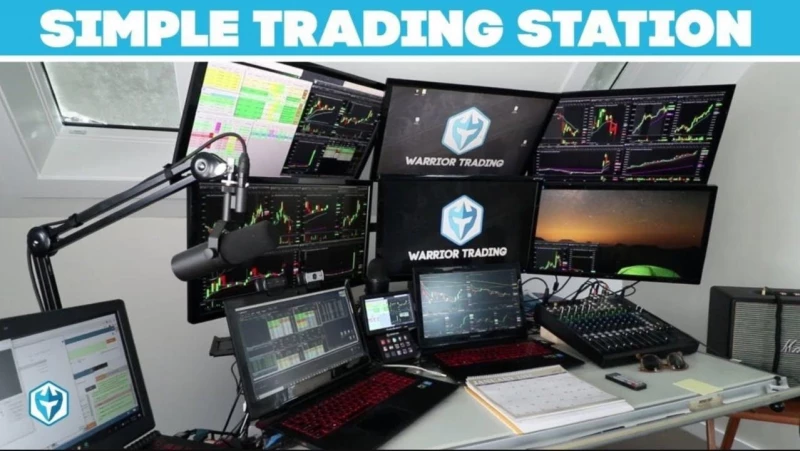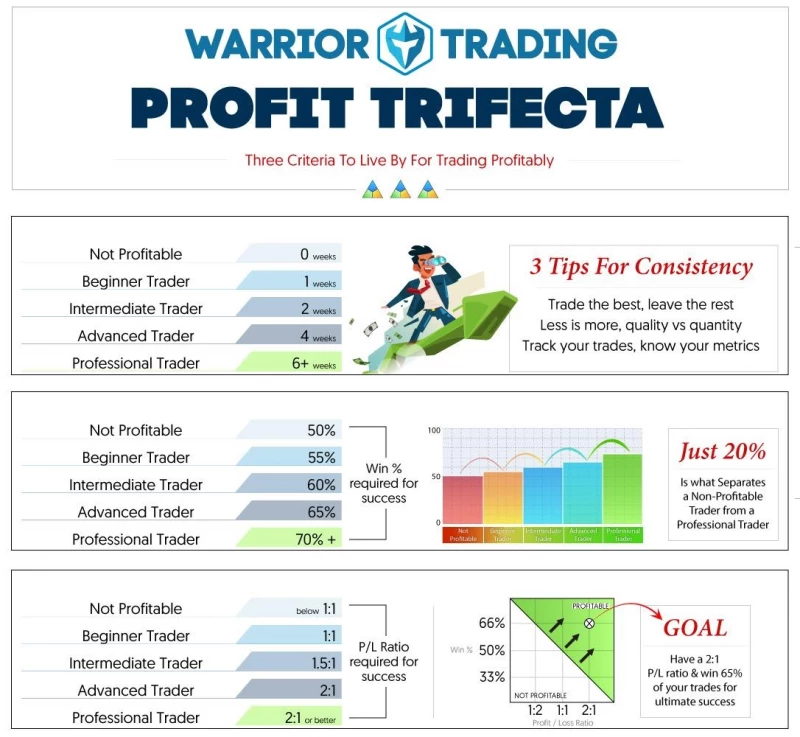Ross Cameron was brought up in Vermont, the USA. He graduated from the College of Vermont with a Bachelor of Arts. While still at school, he worked part-time in design and mastered the creation of engineering documentation in AutoCAD. Ross lived in Manhattan in the mid-2000s and worked for an engineering and design bureau. Ross figured he could accomplish more if he learned to manage his portfolio himself. He came back to Vermont and started day trading with low-top stocks under $20.

In 2012, Ross established Warrior Trading, a website for brokers to learn and get some thoughts from. He dreamt of creating a network, where brokers would be in contact with different experts. According to one review by Warrior Trading, this community provides fantastic free and paid resources for education in trading, and those who want to introduce themselves to the world of trading can try downloading a Warrior Trading torrent.
In 2014, he started organizing educational courses where he taught:
- Risk management;
- Choice of prospective stocks;
- Entry safety.
Ross has diverse hobbies: gardening, sailing, and repairing vintage Mercedes engines. He continues to live with his family in Vermont, Waterloo.
A Hard Path To Success
“Figuring out how to day trade was one of the most challenging assignments in my life,” – Ross Cameron states. “At the point when I initially typed “how to day trade” into the search bar, I had no clue about how profound the inquiry I requested was. I felt that figuring out how to exchange stocks intraday resembles figuring out how to replace the oil in a vehicle. I figured I could simply adhere to certain directions, become familiar with a couple of tricks, discover uncommon strategies, and begin making extra money each week. It took me a year and a half before I began making steady profit in the market. Imagine attempting to replace the oil in your vehicle for a year and a half without progress! The disillusion that I encountered during that period was most likely no less”.

Only 10% Make it to the Top
Most of you have presumably heard the statement that only 10% of brokers reach success in day trading, while the rest lose all they have.
Ross Cameron heard this rumor, too, yet he chose to take a chance any case. He concluded that 90% who come up short might not have put in sufficient effort, or just conditions have failed them – they must be occupied by another activity, family, kids, and so on. At the point when he started trading, his life was exceptionally plain.
He simply moved from New York to Vermont and was working as an independent expert for an engineering firm in New York. He devoted all his free time was to learning how to trade. Looking back, he says he needed to comprehend the reasons why 90% of brokers come up short back then. Early comprehension of the underlying causes of failures could help him make timely corrections.
Why do Traders Fail?
After trading for years, Ross Cameron claims there are two main reasons for failure:
- The principal reason is simple – a lack of preparation. A huge number of dealers pump a lot of cash into their exchanging account and, having no understanding of how the market works, start trading right away. Any endeavor to trade with no comprehension of the market along with tycoon dealers and multi-billion dollar stocks is a sure way to a fiasco. The merchant must concentrate his endeavors on getting knowledge and skills, that is, and spend at least one-month trading on a demo account. He should ensure that he can make a benefit, and start trading with real money afterward.
- The second most common reason behind failure is a lack of risk management skills. Risk is a crucial principle that any trader must comprehend. Each deal incorporates an investigation of risks and benefits. Any decent dealer has one basic measurement: their average profit is always higher than their losses. This approach often proves to be right. Beginners who lose more than they earn need to adjust their strategy. They can’t make a profit until they make changes to their trading approach. A history with great statistics guarantees beneficial trading can be acquired because of executing an all-around characterized exchanging methodology.
How to Develop a Strategy?
Every broker must have an exchanging technique with a goal of making a profit. Ideally, it should be a document that includes the following information:
- The stocks you are exchanging;
- Acceptable price range;
- Market capitalization;
- Ways of searching for deals;
- Entry requirements;
- Precision level.
It took Ross Cameron 18 months to develop his strategy until it was finally fully formed and well tested.
If you have an opportunity, learn trading with a professional broker – he can explain some typical mistakes to you and help you to find the best approach for you.
The Secret Of a Successful Stock Trading
When day trading, Ross Cameron finds the most potentially profitable stocks. But it’s not just a talent – this is a skill that took many years to master.
Here’s what he says about the start of his brilliant trading career:
“I started to study. I looked at the charts and tried to find some clues as to why a particular stock should have been bought on a particular day. A strategy started shaping itself. This was only the initial stage of developing my strategy, which lasted for about two years. I distinguish two stages in trading: the first is a development of a strategy, the second is trading according to a successful strategy. The second stage is simple. And while everyone can have hard days, trading with a successful strategy isn’t difficult. The hardest part of this process is to create a strategy.”
The real turning point happened when Ross realized that every day there are stocks that move 20% – 30%. The trick is to find these stocks early in the morning when they have only gone 5% – 10%. In 8-9 cases out of 10, they can be found by the gap at the premarket or by the news release before the trading opens up.
A report comes out, a new product is announced, or some positive fundamental news is published. And we see how this positive news is reflected on the chart as a price gap. Having noticed this, we check which news came out, and then we start working on our checklist.
Once Ross Cameron developed this scheme, he gained a fuller control over the process. At first, he realized that a few stocks were generating a really big move every day. His task was to analyze these stocks at the end of each day. What caused the movement? Where was the price on the daily chart? What was the news? He analyzed as many common parameters as possible to understand how to turn all this into a profitable day trading strategy.

How To Define a Quality Stock?
Here comes one of the best trading advice from Ross Cameron. He has compiled a checklist of criteria for a quality stock. This list includes the following:
- The stock must have a gap up at least 10%. Ideally, traffic should be on the news;
- It can be some kind of sectoral catalyst or just a technical breakdown;
- The overall number of the company’s shares must not exceed 100 million. This was one of Ross’ initial mistakes. He worked with such shares as Bank of America (BAC) and Caterpillar (CAT), which have several hundred million or even billion shares outstanding, and those shares are not trading. They are a great investment tool, but they are not suitable for the trader;
- Traders and investors are looking for different stocks on the market. You need to understand which category you belong to, and this depends on your risk tolerance;
- Ideally, a stock should have a strong daily chart. This is a rather subjective criterion since everyone has their idea of the strength of the stock. For Ross Cameron, this is a stock trading above its 200-day Exponential Moving Average (EMA). If the stock is below the 200-day EMA, he can still pick it up if the stock was weak and there is enough room to move before the 200-day EMA;
- The stock should have made big moves before. If a stock hits the scanner after a gap up and looking at its history, you see that there was a 60% movement in it three months ago, there is a high probability that other traders will also see this movement and think the same: “This move can happen again today. I don’t want to miss it, so I better get in early.” As a result, we will see a strong continuation of the movement.
So, What is Ross Cameron’s Net Worth?
There were a lot of rumors regarding whether Ross Cameron’s fortune is real, or it’s just a scam, even though he is always transparent about his profit and shows his trades publicly. He posted proof in his blog to display the earnings in 2016-2017. Even though haters are raging against his high-priced products, his trading talents cannot be overlooked: they helped him earn about $4 million from his business.
The Bottom Line
Like many other successful traders, Ross Cameron proves that profit doesn’t show up all of a sudden. It’s not about luck – it’s essentially about hard work, a ton of practice (with a lot of failures and disappointments), and the development of a working strategy. By following his pro tips and getting in touch with professional traders, like the ones in the Warrior Trading website, beginners can elaborate their unique tactics with losses minimized.

Leave A Comment?
You must be logged in to post a comment.